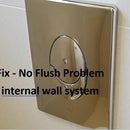Introduction: D.I.Y. Inline Aquarium Heater
One of my hobbies is keeping fresh water tropical fish. I used to keep them when I was young and have taken it up again in recent years. Boy, how things have changed in this hobby since the first time I had an interest. Decent filters, fully submersible heaters, CO2 injection, UV sterilizers, plant fertilisers, LED lighting with full spectrum light for stimulating plant growth - the list goes on. I also love the lush green look of a heavily planted tank.
To maintain a healthy environment, you need good filtration and a water heater to provide an ambient temperature all year round to keep your fish happy. These two items both need to intrude into the aquarium and somewhat detract from the overall appearance. The filter inlet pipe is unavoidable (unless you go down the path of expensive plumbing) as it is best to draw water from the bottom of the tank for proper circulation. I painted my outlet pipe black in the hope if having it fade into the background and not been seen. The heater, on the other hand, could be removed from view and placed externally i.e. somewhere within the filtration system. You can of course buy ready-made inline heaters although the quality brand heaters are relatively expensive. There are cheap unbranded heaters available, but their quality is unknown, or you can build this DIY approach which set me back about $40.
Supplies
Section of PVC Pipe to incorporate your heater (I used 65mm diameter)
3 PVC End caps
2 Threaded Barbed hose connectors
1 Cable gland
1 PVC Y junction
I had some left-over PVC pipe from some plumbing work I did in my shed a while back which I could use.
I purchased the barbed hose connectors, Y junction and end caps from an irrigation shop.
The cable gland you can purchase from an electrical store (where electricians buy their stuff).
Step 1: Sizing Up What You Need
Cable glands, also known as cord grips or cable connectors are used in the electrical industry as a sealing or termination device. The type I used are intended to resist dripping water or water pressure and are fitted with a synthetic rubber or elastomer seal which compress around the heater tube when tightened. Cable glands are readily available on EBAY or your local electrical store which is where I purchased mine.
NOTE! Make sure it has an IP68 rating which guarantees that it is waterproof.
So first of all, you need to start with the cable gland with an opening that accommodates the diameter of the top end of your heater where the minimum water level indicator is marked. Mine is marked with a wave pattern.
The cable gland to suit my heater had a threaded end of 50mm in diameter. PVC pipe in 65mm pipe is readily available where I live so went with that.
Step 2: Starting the Build - Hose Connectors
My heater was 45cm long so I cut a length of PVC pipe long enough to extend onto the Y junction. I added a few centimetres to my PVC cut-off so as to have plenty of space lengthwise to comfortably house my heater.
For two of the end caps, I drilled a 32mm hole in the middle of each to accommodate the threaded ends of my barbed hose connectors.
The threaded hose connectors come without a nut and the store only sold brass nuts to fit. Not wanting to incorporate brass into my aquarium (causes liver damage to fish long term) I hunted around for someone who sold plastic nuts.
Couldn't find any but as luck would have it, a garden hose fitting fitted perfectly after cutting the end off it, turning it into a makeshift nut. I then proceeded to fill the ends up with silicone to remove any air pockets that might form when in operation.
Step 3: Fitting the Cable Gland
To fit the cable gland, i needed to cut a 55mm hole in one of the end caps. Not having a hole saw that size, and not wanting to fork out for this one off exercise, I drilled a 50mm hole and took it up to 55mm with a drum sander.
My next problem was with the hex nut that secured the cable gland, just being slightly too large to fit within the end cap. I fixed this problem by cutting the six tips off the nut with my handy dremmel.
Step 4: Joining the Components Together
An important note to consider when joining PVC pipe is to apply a primer. It removes the shiny surface and other possible contaminants that may affect a good seal. You certainly don't want a joint failure in this situation, springing a leak and flooding the floor...my life wouldn't be worth living.
In fact, I always apply to the complete surface if I'm going to paint what ever i'm making, as it improves the adhesion of paint to the PVC surface as well.
Step 5: Giving It a Paint Job
With all the components joined together, I thought I would improve the overall look by giving a shiny coat of paint. A pretty pointless exercise though, as mine will be hidden out of sight in the cupboard below.
Step 6: Final Outcome
Here's a short video of my tank with the heater no longer in view.
Accompanying music - Underwater Coolness by Eric Matyas

Participated in the
1000th Contest











